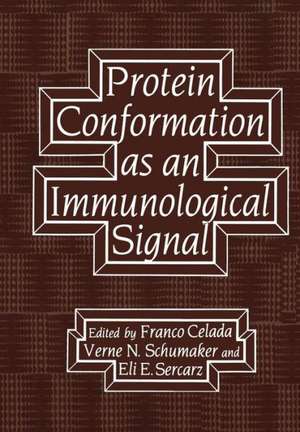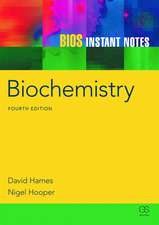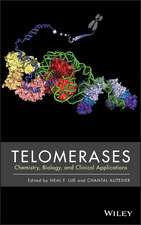Protein Conformation as an Immunological Signal
Autor Franco Celada, Verne N. Schumaker, Eli E. Sercarzen Limba Engleză Paperback – 21 dec 2011
Preț: 405.48 lei
Nou
Puncte Express: 608
Preț estimativ în valută:
77.60€ • 80.71$ • 64.06£
77.60€ • 80.71$ • 64.06£
Carte tipărită la comandă
Livrare economică 14-28 aprilie
Preluare comenzi: 021 569.72.76
Specificații
ISBN-13: 9781461337805
ISBN-10: 1461337801
Pagini: 524
Ilustrații: 520 p. 32 illus.
Dimensiuni: 170 x 244 x 28 mm
Greutate: 0.83 kg
Ediția:Softcover reprint of the original 1st ed. 1983
Editura: Springer Us
Colecția Springer
Locul publicării:New York, NY, United States
ISBN-10: 1461337801
Pagini: 524
Ilustrații: 520 p. 32 illus.
Dimensiuni: 170 x 244 x 28 mm
Greutate: 0.83 kg
Ediția:Softcover reprint of the original 1st ed. 1983
Editura: Springer Us
Colecția Springer
Locul publicării:New York, NY, United States
Public țintă
ResearchCuprins
Topic I. The Influence of Antigen Upon the Conformation of Antibody.- Antibody-Hapten Binding Kinetics, Conformational Transitions and Domains Interactions.- Dynamic Aspects of Signal Transfer in Antibody Molecules.- Could Aggregation of Human Immunoglobulins Bring About Appearance of Novel Antigenic Sites?.- Topic II. Structure/Function Interrelationships in IgM and IgG.- Immunoglobulin M Conformational Change is a Signal for Complement Activation.- Expression of Fc Effector Function in Homogeneous Murine Anti-ARS IgM.- The Localization of Effector Sites on Immunoglobulin G.- Human Fc? Fragment: Location of Acidic Residues Involved in Complement Activation.- Topic III. Structure Of C1, Interactions Between its Subunits and Other Macromolecules.- Ultrastructure of the First Component of Human Complement.- Binding of Human 125I-Fibronectin to C1q and to Human Monoclonal Myeloma IgG Subclasses.- Biochemical Specificity of Human Complement Component C1q.- Sequence Studies on Human Complement Subcomponent C1r.- Topic IV. The Activation of the First Component of Complement.- Dissociation of C1 and Concentration Dependence of Its Activation Kinetics.- Fluid Phase Activation of Proenzymic C1r.- Activation of Mammalian Complement by Chicken C1q.- Topic V. The Importance of Antigen Conformation for Antigenicity and Immunogenicity.- Conformational Antigenic Determinants in Proteins.- Topographic Antigenic Determinants Detected by Monoclonal Antibodies to Myoglobin.- Role of Conformation on the Antigenic Determinants of Tobacco Mosaic Virus Protein.- Monoclonal Antibodies May Block Sterically or Conformationally the Antigenic Determinants of Human Growth Hormone.- An Immunochemical Study of the Changes in Conformation Undergone by Two Domains of the Tryptophan-synthetase ?2Subunit upon Association.- Topic VI. The Changes in Protein Antigen Conformation Induced by Antibody.- Antibody-mediated Activation of Genetically Defective Escherichia coli Galactosidases by Monoclonal Antibodies.- Synergistic Activation by Monoclonal Antibodies of ?-galactosidase from Genetically Defective E. coli.- Antibodies as Probes of Protein Structure.- Is There a Preferential Pathway for Antibody-mediated Enzyme Activation?.- Topic VII. The Recognition by T Cells of Protein Antigens.- General Introduction.- VIIa. Which are the Antigenic Determinants that T Cells Recognize?.- T Lymphocyte Recognition of Small Peptide Antigens: Formation of Neoantigenic Determinants and Clonal Frequency Resulting in Ir Gene Control.- The Antigenic Structure of Bovine Serum Albumin: T-Cell, B-Cell, and Ia Determinants.- Attempts to Understand the Function of Macrophages and Antigen Specific Cells in their Mutual Interaction.- A Possible Immunodominant Domain on Myoglobin Recognized by T Lymphocytes.- VIIb. What is the Role of MHC and Other Genes in the Antigen-presenting cell?.- Antigen Presenting Function of Macrophages.- The Sorting-Out Problem in Antigen Presentation.- Genetic Analysis of Responsiveness to Adjuvant-Free Immunological Signals: Transfer of Genes from Responder Strains (SJL/J and CE/J) to a Nonresponder Background Uncovers a Requirement for H-2 Heterozygosity.- How is Adjuvanticity Recognised?.- VIIc. Analysis of the Ternary Complex of Antigen: MHC: and T-cell Receptor with T cell Clones.- Specificity and Restriction of T Cells in a System of Complementing Ir Genes.- Evidence for Ia-Antigen Interaction in T Cell Activation.- Somatic T Cell Hybrids in the Analysis of H-2 Restriction and Antigen Recognition.- Topic VIII. Structural Aspects of T-B and T-TInteraction.- Antigen Bridging in T Cell-B Cell Interaction: Fact or Fiction?.- B Cells as MHC Restricted Antigen Presenting Cells: A Model for T-B Interaction.- A View from the Bridge: Antigenic Determinants in Immunoregulation.- Antigen Structures Used by Regulatory T Cells in the Interaction Among T Suppressor, T Helper and B Cells.- Activation of Human B Lymphocytes by Antigen Specific T Cell Lines.- T Helper Cell Recognition of Two Types of Mouse Lambda Light Chains.- Effects of Anti-Idiotypic Sera (Ab-2) and Monoclonal Idiotypic Antibody (Ab-1) on the Immune Response to a Simple Polypeptide Antigen with only two Immunologically Active Epitopes. Analysis of the Response at the Unideterminant Level.- Topic IX. Effector Mechanisms for Cell Signaling Resulting from Antigen-Antibody Interactions.- The Role of IgE and its Receptor in Mediating Secretion.- A New Method for Monitoring Intracellular Free Ca2+ in Lymphocytes. Concanavalin A and Anti-Igm Induce an Early Rise of Cytoplasmic Free Ca2+.- B Lymphocyte Stimulation and Suppression by the Fc Portion of Immunoglobulin.- Modulation of Immunological Reactivity by the Fc Piece of Immunoglobulin.- T Cell Replacing Factor (TRF)-Induced IgG Production in a Human B Cell Line and the Mechanism of Transmembrane Signaling through TRF-Acceptors.









